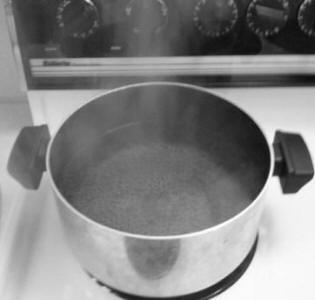|
Reclaiming The
Kitchen
|
|
|
How to Boil Water
 This may seem like it's too obvious even for the most
beginning of beginners... but there are a few important notes about
boiling water that will make your life easier. This may seem like it's too obvious even for the most
beginning of beginners... but there are a few important notes about
boiling water that will make your life easier.
Container
You may boil water in any sort of pot or kettle.
Generally, you want something with a lid, and a fairly thin bottom so
the heat is transferred more directly from the burner. Water will boil
faster in a short, wide container than in a tall narrow one for two
reasons... the water in the tall narrow pot actually boils at a higher
temperature because the water at the bottom of the pot is under greater
pressure from the water at the top. Also, more of the water in the
short, wide container is closer to the burner, decreasing the time it
takes for the water to heat up.
Heat
When boiling water, you don't have to worry about it
burning or sticking, so you want to turn the burner up to its highest
setting. Depending on what you're using the water for, you may want to
turn the heat down once you've reached the boiling point.
Altitude
The temperature at which water boils varies
depending on the altitude where you are boiling the water. At sea level,
water boils at 100 degrees centigrade, however as you go up in altitude,
water boils at a lower temperature. This is because as you go up in
altitude, there is less atmospheric pressure. So if you're cooking at a
high altitude, water will take less time to boil, but the water will not
be as hot as it would be at sea level, so things may take longer to
cook.
Additives
When you add salt or sugar to the water (or just
about any other substance) it raises the boiling point slightly. This
means that the water will be hotter, and foods will cook faster. This
effect also holds true if you have "hard water" (water containing a
great deal of dissolved minerals).
Boiling Water in the Microwave
You need to use extreme
caution when boiling water in the microwave. Unlike boiling water on a
stovetop, when you heat water in a microwave, you can actually get it
hotter than the boiling point, with no visible bubbles. The bubbles will
only appear once the surface tension is broken (like when you take it
out of the microwave, or put something into the water), and by that
point the water may be "super-heated" and the bubbles or steam can shoot
up and cause injury. We suggest that you only use the microwave for
boiling water one cup at a time (like for tea) and even then, don't fill
the cup more than 3/4 of the way full, and use caution when removing it
or adding the tea bag. |
|